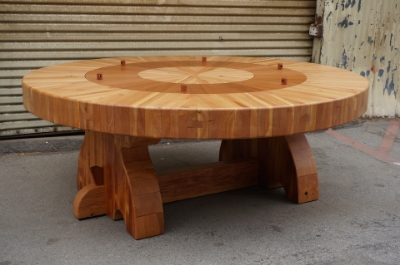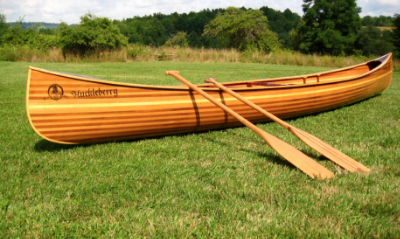ST: Can you explain what “traditional joinery and sustainable slab rescue” is?
NO: “Traditional joinery:” Missionary position? The knee bone connected to the thigh bone, knuckling under or above, having one’s nose in or out of joint, etc.? Or you may be referring to methods of joining the discrete implements in a piece of wooden furniture to one another without fasteners such as nails or screws. For example, the four sides of a Shaker blanket chest are traditionally joined to one another by cleverly interlocking dovetail joints at the corners. Traditional “post-and-beam” or “timber-frame” construction heavily utilizes the mortise-and-tenon joint, which can be exemplified by making a “vessel” (mortise) with one hand, and inserting the index finger (tenon) of the other hand into it. Repeating this traditional action brings us full circle to the missionary position.
“Sustainable Slab Rescue” refers to the practice of re-using local trees that have been felled by storms, nature, or construction needs, by milling them into table slabs and other lumber. Many urban trees become landfill fodder, or at best, firewood, while woodworkers and homebuilders rely upon lumber companies to harvest forest products from distant locations and then expend even more fossil fuels to transport those two-by-fours to our lumberyards. By setting up a local milling service, we can give our local trees a valuable second life as furniture and home decor, while burning a hell of a lot less diesel shipping in Douglas Fir timbers from British Columbia.
ST: How did you get into woodworking?
NO: I grew up in a farming family in Minooka, Ill., learning to use tools for carpentry and mechanic work from a young age. I framed houses for a summer, then did some roofing before learning to build professional theatre scenery. I made a good half of my living in Chicago building scenery by day and acting in plays at night, which further honed my competence in working with tools in a shop. Once I moved to Los Angeles in 1997, I began to construct decks and cabins in peoples’ yards, which included teaching myself post-and-beam construction, particularly inspired by the local works of the architects Greene and Greene. One day I was chopping out a large mortise, when I realized that traditional furniture utilized the exact same joinery just on a smaller scale, and I was bewitched. A friend gave me Fine Woodworking Magazine and I devoured it, a matriculation that continues to this day.
ST: Is woodworking a hobby or passion for you?
NO: This question confuses me. It seems to presuppose that one may not be passionate about one’s hobby. To my way of thinking, a hobby can be precisely described as a productive diversion in one’s life about which said person is passionate. As in, “Fred’s probably out in the garage building one of his popsicle-stick ‘Star Wars’ vehicles. It’s his passion.” If you mean to ask if woodworking is a hobby as opposed to something more, say a vocation, then I would have to say it is a vocation. It is a discipline. A true woodworker is more than a hobbyist, if one considers “hobby” to represent a diversionary activity like repairing antique pocket-watches, or photographing and cataloging local bird species. Woodworking, I think it’s safe to say, requires a greater commitment than any mere hobby. What I mean is that woodworking is a craft that, once begun, continues to hold the woodworker in its grip, rewarding her or him with a progressive accumulation of knowledge throughout a lifetime of craft. If I were to simply enjoy building birdhouses in my spare time, with no interest in heightening my skills or tool knowledge, then I would consider myself a hobbyist who uses woodworking to make my charming product, but I would demur at being referred to as a “woodworker.”
On the other hand, if one is besotted with the tutelage of all the great woodworkers who have come before and left for us their instruction in books and periodicals, or simply in their works in homes and museums, then I would consider woodworking an obsession and a vocation. This is the case with me. I began, as many do, by building a box. Then I built a box with a lid. I chose each new project based upon some new joinery technique so that my knowledge and skills would progress equally apace. Then I built a table, then more tables. I built a small four-foot lapstrake rowboat as a cradle. I built a canoe. I built another canoe. Then I built a ukulele. I am itching to get back to my shop to build several more ukuleles so I may then graduate to acoustic guitars. Beyond that, I may build more boats or instruments—the mandolin and the violin are both calling my name from afar. In a few months it looks like I will get to take a Boston workshop in building a traditional Windsor chair, and that has me bristling with excitement, as the techniques involved are not yet ones that I wield in my personal bag of tricks, and in woodworking, every new technique becomes part of the invaluable body of knowledge that allows the woodworker to solve each unique problem as it arises.
ST: What was the first item you made out of wood?
NO: In truth, a crappy tree house down by the creek with my pal Steve Rapcan. My father and I also built a small barn at our house before I began framing houses. The first item I made once I got turned on to woodworking was a jewelry box for my wife, who was my girlfriend at the time.
ST: Do you have any pre-woodworking rituals?
NO: No specific rituals per se, although consuming a bounty of bacon and eggs doesn’t hurt. Woodworking requires a clear head and perspicacity when it comes to safety around the tools and materials.
ST: What advice would you give to a first-time woodworker?
NO: Plan to make mistakes. Practice joinery and get to be comfortable with your tools on scrap wood before you ruin some expensive walnut.
ST: Is there a piece you have made that you are most proud of?
NO: To date, I am most proud of my first canoe, Huckleberry, built with the techniques I learned from Ted Moores in his book CanoeCraft, and his plans from Bear Mountain Boats. That noble vessel, my main ride, also served as the canoe of Ron Swanson on my television show “Parks and Recreation” until the series finale in which he paddled into the sunset in my second canoe, Lucky Boy.


















